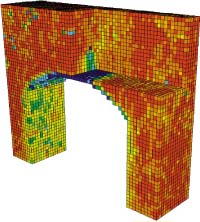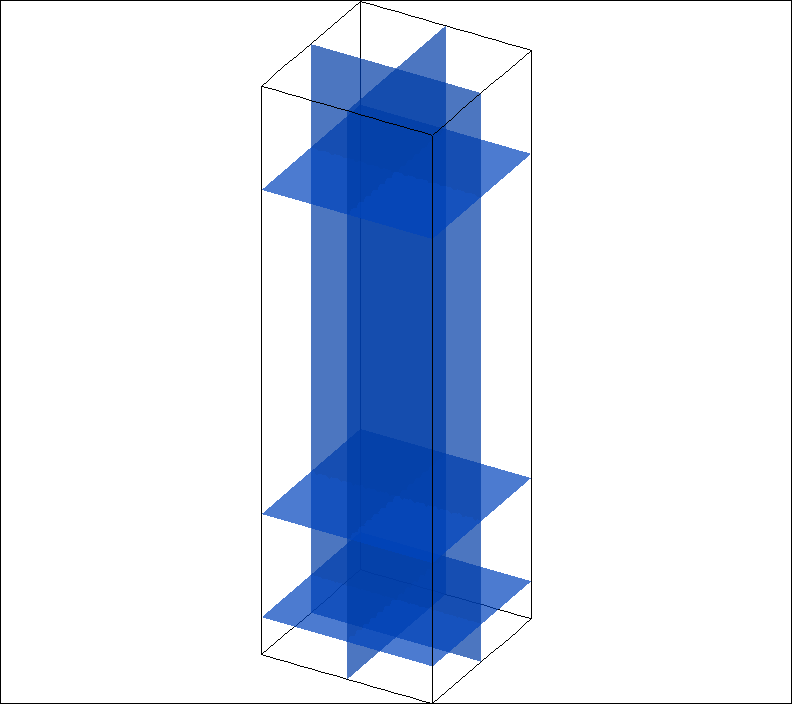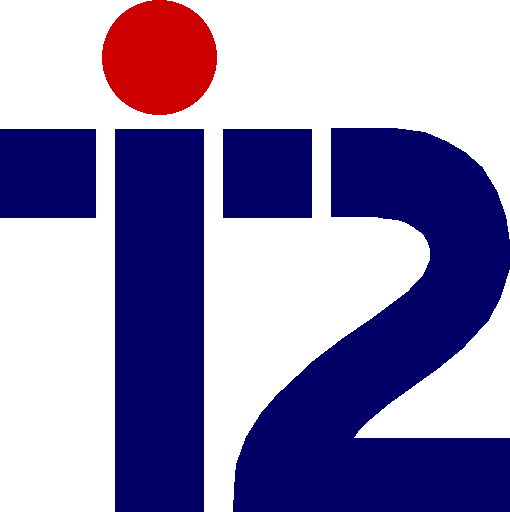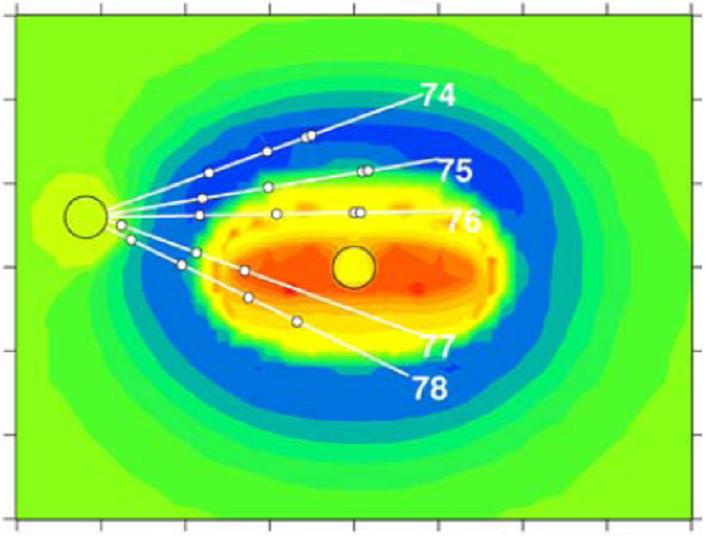TOUGH: Suite of Simulators for Nonisothermal Multiphase Flow and Transport in Fractured Porous Media
 The TOUGH (“Transport Of Unsaturated Groundwater and Heat”) suite of software codes are multi-dimensional numerical models for simulating the coupled transport of water, vapor, non-condensible gas, and heat in porous and fractured media. Developed at the Lawrence Berkeley National Laboratory (LBNL) in the early 1980s primarily for geothermal reservoir engineering, the suite of simulators is now widely used at universities, government organizations, and private industry for applications to nuclear waste disposal, environmental remediation problems, energy production from geothermal, oil and gas reservoirs as well as gas hydrate deposits, geological carbon sequestration, vadose zone hydrology, and other uses that involve coupled thermal, hydrological, geochemical, and mechanical processes in permeable media. The TOUGH suite of simulators is continually updated, with new equation-of-state (EOS) modules being developed, and refined process descriptions implemented into the TOUGH framework (see the overview of the TOUGH development history). Notably, EOS property modules for mixtures of water, NaCl, and CO2 has been developed and is widely used for the analysis of geologic carbon sequestration processes.
TOUGH and its application have been the subject of more than 500 peer-reviewed journal articles, conference proceedings, and project reports. TOUGH and its various modules are documented in a series of manuals.
Karsten Pruess was presented a Lifetime Achievement Award for Development of the TOUGH Codes on Tuesday, September 18th at the 2012 TOUGH Symposium in Berkeley, CA.
TOUGH questions, comments, and suggestions as well as replies can be posted in the User Forum.
Below you will find a quick summary of the suite, with links to more detailed information on each module:
The TOUGH (“Transport Of Unsaturated Groundwater and Heat”) suite of software codes are multi-dimensional numerical models for simulating the coupled transport of water, vapor, non-condensible gas, and heat in porous and fractured media. Developed at the Lawrence Berkeley National Laboratory (LBNL) in the early 1980s primarily for geothermal reservoir engineering, the suite of simulators is now widely used at universities, government organizations, and private industry for applications to nuclear waste disposal, environmental remediation problems, energy production from geothermal, oil and gas reservoirs as well as gas hydrate deposits, geological carbon sequestration, vadose zone hydrology, and other uses that involve coupled thermal, hydrological, geochemical, and mechanical processes in permeable media. The TOUGH suite of simulators is continually updated, with new equation-of-state (EOS) modules being developed, and refined process descriptions implemented into the TOUGH framework (see the overview of the TOUGH development history). Notably, EOS property modules for mixtures of water, NaCl, and CO2 has been developed and is widely used for the analysis of geologic carbon sequestration processes.
TOUGH and its application have been the subject of more than 500 peer-reviewed journal articles, conference proceedings, and project reports. TOUGH and its various modules are documented in a series of manuals.
Karsten Pruess was presented a Lifetime Achievement Award for Development of the TOUGH Codes on Tuesday, September 18th at the 2012 TOUGH Symposium in Berkeley, CA.
TOUGH questions, comments, and suggestions as well as replies can be posted in the User Forum.
Below you will find a quick summary of the suite, with links to more detailed information on each module:
 TOUGH3 is the basic simulator for flow and transport in fractured porous media. It was developed for problems involving strongly heat-driven flow and uses a multi-phase approach to model fluid and heat flow, which fully accounts for the movement of gaseous and liquid phases, their transport of latent and sensible heat, and phase transitions between liquid and vapor. TOUGH3 replaces TOUGH2 and TOUGH2-MP in the TOUGH family of codes, and can be run in serial mode, on multi-processor machines, or massively-parallel clusters.
Features & Capabilities | Licensing & Download | Documentation | User Forum
TOUGH3 is the basic simulator for flow and transport in fractured porous media. It was developed for problems involving strongly heat-driven flow and uses a multi-phase approach to model fluid and heat flow, which fully accounts for the movement of gaseous and liquid phases, their transport of latent and sensible heat, and phase transitions between liquid and vapor. TOUGH3 replaces TOUGH2 and TOUGH2-MP in the TOUGH family of codes, and can be run in serial mode, on multi-processor machines, or massively-parallel clusters.
Features & Capabilities | Licensing & Download | Documentation | User Forum
 iTOUGH2 (inverse TOUGH2) is a computer program that provides inverse modeling capabilities for the TOUGH codes. iTOUGH2 solves the inverse problem by automatically calibrating a TOUGH2 model (or any other model) against observed data. Any TOUGH2 input parameter can be estimated based on any observation for which a corresponding TOUGH2 output can be calculated. An objective function measures the difference between the model calculation and the observed data, and a minimization algorithm proposes new parameter sets that iteratively improve the match. Once the best estimate parameter set is identified, iTOUGH2 performs an extensive error analysis, which provides statistical information about residuals, estimation uncertainties, and the ability to discriminate among model alternatives. Furthermore, an uncertainty propagation analysis allows one to quantify prediction errors.
iTOUGH2 (inverse TOUGH2) is a computer program that provides inverse modeling capabilities for the TOUGH codes. iTOUGH2 solves the inverse problem by automatically calibrating a TOUGH2 model (or any other model) against observed data. Any TOUGH2 input parameter can be estimated based on any observation for which a corresponding TOUGH2 output can be calculated. An objective function measures the difference between the model calculation and the observed data, and a minimization algorithm proposes new parameter sets that iteratively improve the match. Once the best estimate parameter set is identified, iTOUGH2 performs an extensive error analysis, which provides statistical information about residuals, estimation uncertainties, and the ability to discriminate among model alternatives. Furthermore, an uncertainty propagation analysis allows one to quantify prediction errors.
iTOUGH2 Website | User’s Guide | Sample Problems | Command Reference | Bibliography | Licensing & Ordering | User Forum
 TOUGHREACT is a numerical simulation program for chemically reactive non-isothermal flows of multiphase fluids in porous and fractured media, developed by introducing reactive chemistry into the multiphase flow code TOUGH2. Interactions between mineral assemblages and fluids can occur under local equilibrium or kinetic rates. The gas phase can be chemically active. Precipitation and dissolution reactions can change formation porosity and permeability, and can also modify the unsaturated flow properties of the rock.
Features & Capabilities | Licensing & Ordering | Documentation | User Forum
TOUGHREACT is a numerical simulation program for chemically reactive non-isothermal flows of multiphase fluids in porous and fractured media, developed by introducing reactive chemistry into the multiphase flow code TOUGH2. Interactions between mineral assemblages and fluids can occur under local equilibrium or kinetic rates. The gas phase can be chemically active. Precipitation and dissolution reactions can change formation porosity and permeability, and can also modify the unsaturated flow properties of the rock.
Features & Capabilities | Licensing & Ordering | Documentation | User Forum
Features & Capabilities | Licensing & Ordering | Documentation | User Forum
Additional Information
- For technical questions, comments, and suggestions, use the User Forum.
- For information on the TOUGH Symposia and future Training Courses, please add your name to the TOUGH Email List.
- For technical information, check the User Forum or contact the developer team.
- For questions about licensing, please contact the Technology Transfer Department.